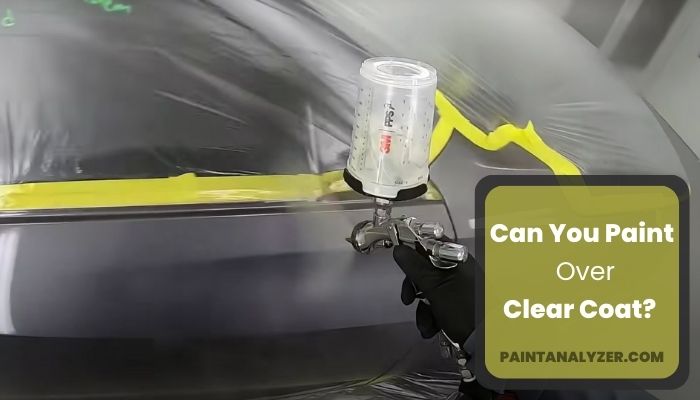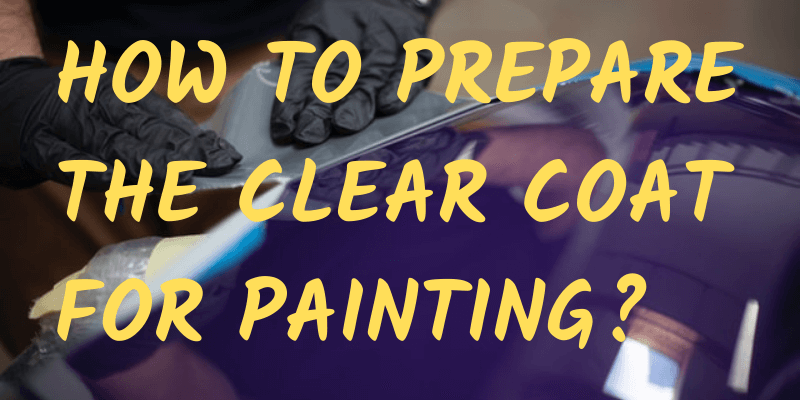At its core, a clear coat is a layer that is of paint or resin. This layer will be transparent, just like the name suggests. Its most usual use case is over the base coat, and people use it to protect the paint layer beneath from oxidation or wear. However, what if you do not like the color underneath the clear coat after a while?
Can you paint over clear coat, or do you need to get the topcoat base coat out of the surface to give it a new look? You can get to know all about the topic and more if you keep reading. We will cover every piece of information regarding what you can do or not do over the clear coat. So, let us get into it!

Is It Possible to Paint Over Clear Coat?
Yes, you can certainly paint over the clear coat. However, some things need to be in your consideration before you decide to try out the new color on the clear coat. As you know by now, the clear coat is basically a protective layer that will mostly be of paint or resin. Also, it is clear or transparent in color.
Nonetheless, as it is of paint or resin, the surface will be smooth. An extremely smooth surface is not adequate for painting. The color will not simply bond with the surface, and you will be wasting your precious paint and time by trying to paint over the clear coat without preparing it.
Furthermore, you need to apply multiple coats of the new color after preparing the surface. One coat will not be enough to hide the base coat under the clear coat. So, you should get a good amount of the new paint before you start working on the project.
How to Prepare the Clear Coat for Painting?

As mentioned, the surface of the clear coat will be incredibly smooth. This smooth nature of the surface will not make the new paint adhere to the surface. So, you should sand the surface before working with the fresh paint. Follow these steps:
Step 1: Carry Out a Wet Sanding First
When it comes to sanding the clear coat, we recommend carrying out a wet sanding first. Wet the sandpaper a little and go over the surface a couple of times. That will make the clear coat scuffed up a little.
Step 2: Use a Sandpaper
Use 1500 grit paper after the wet sanding process. If you do not have any 1500 grit paper available, you can use 1200 or 1600-grit paper. When you are done sanding, clean the surface and get rid of the sanding debris or dust from the surface. These can come into the way when you are painting and mess with the new paint.
Step 3: Get Rid of Any Impurities
Get yourself some wax-removing wipes once you are done with the sanding process. With those, get rid of any of the oil or wax on the surface. This wax or oil can also mess with the new paint and make the surface get an improper finish.
How Do You Paint Over Clear Coat?
So, after you have gone through the preparation process, you will need to follow these steps:
Step 1: Clean the Surface
Give the surface another good wash. We would recommend using a hose connected to a water source because it will let you get most of the loose debris off the surface. However, a bucket of water will also be okay for the task.
Step 2: Prepare the Surface for Paint
You will need to prepare the surface for accepting the fresh coat of paint. For this, we would recommend getting a high-quality primer. The primer will do a proper job of hiding the paint that is underneath the clear coat. It will also make the surface well-prepared to accept the new color.
Apart from holding the color better, the primer will prevent stains from appearing on the surface. However, you can not just start working with the new paint after applying the primer. We would recommend waiting for at least one day. Leaving the primer overnight to dry will also work.
Step 3: Get Yourself the Required Tools
Once the primer dries, get yourself the required tools. If you plan to spray the paint over the clear coat, prepare the sprayer, and if you want to manually paint over the surface, get the roller and paintbrushes.
Step 4: Dress the Surface up with New Paint
Then, carefully do two coats of the new paint. But do remember to let the first coat dry properly before working on the second coat. Now, if two coats do not provide you with the right color profile or finish, you can add another layer of paint. Again, ensure that the second coat is dry before moving on to the third coat.
Related: How Long Does Acrylic Paint Take to Dry?
Watch How to Mix Clear Coat Video
Should I Apply the Clear Coat on the New Paint?
As we have mentioned, a clear coat is primarily there to protect the paint layers. Now, considering that you already opted for the clear coat before in order to protect the previous paint coats, you should opt for the clear coat again. It will protect the fresh paint and allow the coats to last for a prolonged amount of time.
Related: Acrylic Paint Lifespan
Before you do paint over the new coats, consider what type of paint you used. If the new paint is latex, you need to choose a polyurethane or polyacrylic clear coat. For other paints, any clear coat should work fine.
On that note, before you do work with the second clear coat, ensure that the new paint coats are bone dry. If they are wet, the clear coat will ruin the layer and make the surface a whole mess. Check the instruction on the paint container and wait for that amount of time before applying the second clear coat on the surface.
Video on What Happens When You Spray Clear Paint on Faded Paint?
Can You Skim Coat Over a Clear Coat?
Skim coating involves applying a thin layer of joint compound to create a smooth surface, typically used for repairing or refinishing walls. However, attempting to skim coat over a clear coat, such as on a car or furniture, may not yield desirable results. This painting technique for skim coating is best suited for bare surfaces or those with a suitable base for adhesion.
Final Words
To recapitulate, the answer to can you paint over clear coat would be yes. But you should sand the surface with the right sandpaper and apply primer over the surface before you paint over the clear coat. Also, if you plan to apply the clear coat again, choose the right type of clear coat.
